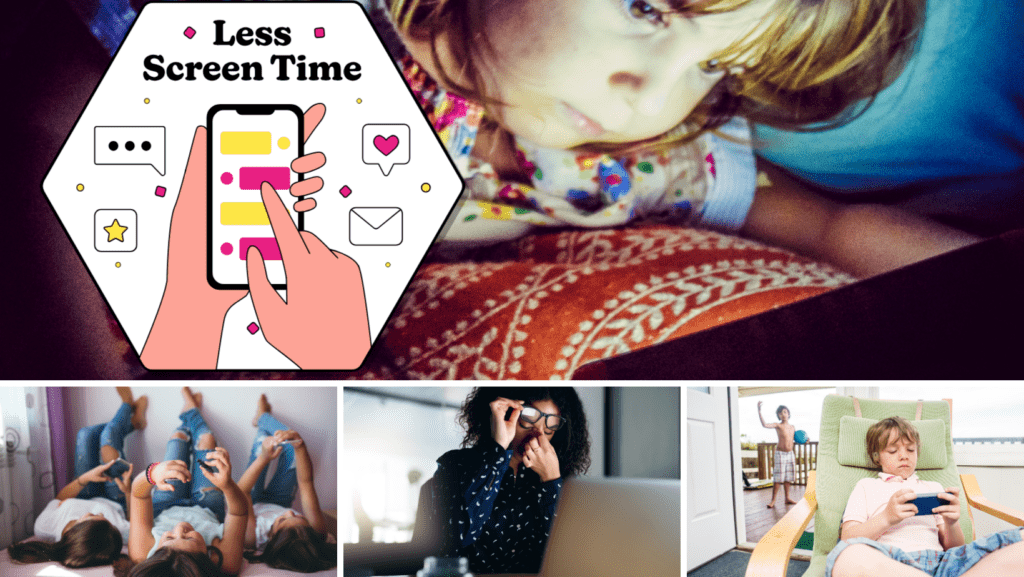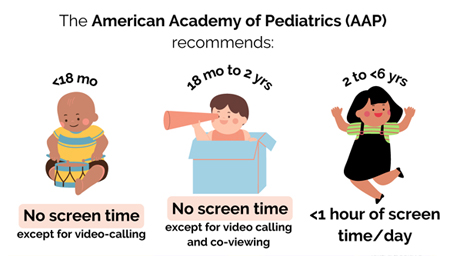What is Recommended Screen Time-
In an era dominated by screens, understanding the optimal usage for different age groups is crucial for overall well-being. This guide will explore the recommended hours, potential negative impacts, and future challenges associated with screen time across various age brackets.

Table of Contents
How much screen time is recommended for the kids?
3-10 Years: Nurturing a Balanced Digital Diet
From nurturing young minds to navigating through different careers and businesses, let’s explore the nuances of recommended screen time across different age groups.

For the youngest age group, 3-10 years, experts advocate a delicate approach. Limiting screen time to 1-2 hours daily for educational content fosters cognitive development.
However, exceeding this recommendation may lead to reduced physical activity and potential sleep disturbances, impacting long-term cognitive growth.
11-18 Years: Striking a Balance Amidst Adolescence
As teenagers grapple with academic pressures and social interactions, striking the right balance is essential.
Recommendations suggest 2-3 hours of productive screen use daily.
Nevertheless, excessive screen time may result in impaired sleep quality and pose challenges to academic performance, potentially influencing long-term social development.
Consequences of overdose of Screen time in Children
According to WHO, higher screen time can show significant developmental consequences,
- Children have difficulty writing.
- They have issues with eye contact and communicating with others.
- Screen time can also be linked to ADHD symptoms (self-regulation).
- Attention deficit, decision-making, and problem-solving abilities are reduced.
- Screen addiction can also lead to psychiatric problems as well.
How much screen time is too much for adults?
Nowadays, many of us spend a significant amount of time glued to our screens.
Whether it’s working on a computer, watching TV, scrolling through social media, or browsing the internet, our eyes are constantly bombarded with digital stimuli.
This has become even more prevalent during the pandemic, as we rely on technology to stay connected with loved ones and work from home.

The alarming thing to know is that the average screen time for adults is about 11 hours per day. Since lockdown, this number has gone up to an astonishing 19 hours per day due to work from home system.
This study found that those spending six hours or more per day watching screens had a higher risk for depression.
This study found that limiting social media use to 30 minutes per day led to a “significant improvement in well-being.” The type and quality of screen time also play a role.
It is to be taken care of that, what kind of content you are consuming online. As the content type can lead to screen addiction, i.e you are so glued to a series or an interesting game that you forget the track of time.
Is all this screen time taking a toll on Adult well-being as well?
Let’s explore the potential negative effects of excessive screen time for adults.

19-30 Years: Balancing Professional and Personal Screens
Young adults find themselves amidst the dual demands of professional and personal screen engagements. It should not lead to screen addiction.
Balancing is key, with experts recommending 3-4 hours of screen time with breaks.
However, prolonged exposure may lead to eye strain, impacting mental health and potentially contributing to long-term stress.
31-45 Years: Navigating Screens in the Midst of Responsibilities
For those navigating the challenges of work, family, and personal time, experts recommend 2-3 hours for work-related screen activities.
However, the negative impacts are notable, with increased stress and potential effects on family dynamics.
Long-term consequences may manifest as strained relationships and potential health issues.
46-60 Years: Screen Time in the Golden Years
Approaching retirement, individuals are advised to limit screen time to 1-2 hours for leisure and learning.
While this allows for relaxation, exceeding these hours may lead to potential isolation and impact mental well-being.
Long-term effects may cause reduced cognitive engagement and potential loneliness concerns.
Current Scenario and Future Challenges
In today’s tech-driven world, exceeding recommended screen time is commonplace. The consequences are evident-sleep disorders, strained relationships, and diminished well-being.
Looking ahead, the proliferation of technology poses future challenges such as increased screen dependency and potential societal disconnect.
Mental Health and screen time are intertwined with each other, even though not backed by solid research but it’s a serious issue for the future generation.

Even if they do not spend time on social media or games, they still have to do many things- studying, working, and communicating with each other, all of these will involve long hours of screen time.
There is a serious need for expert-approved and authorized guidelines on recommended screen time by age group.
It should be a global standard so it would be easier for people to understand it.
Instead of referring to different research papers and figuring out what to follow, they can refer to this global SOP.
Incomplete Data Analysis due to lack of accuracy in reporting-
Data on screen time is often incomplete and misleading. as it completely depends on self-reported data. which can be inaccurate or unreliable.

People may not be aware of how much time they spend using screens, or they may be unwilling to admit to using them more than they do.
Additionally, it is not always clear how to count screen time when multiple devices are used simultaneously.
For example, if someone is watching a movie on their laptop while also checking their phone, how should that be counted?
Due to these limitations, it isn’t easy to draw firm conclusions about the effects of screen time on mental health.
#According to a recent report, GenZ spends around 9 hours of screen time per day
Instead of focusing on recommended screen time as a measure of digital media use, it is more important to understand the quality of the content being consumed and how it impacts individuals’ lives.
Conclusion: Navigating the Digital Age Mindfully

In the digital age, mindful navigation of screen time is crucial for holistic well-being.
As we ponder the impact on different age groups, it becomes evident that balance is the key to a healthy relationship with screens.
Here are some tips for a harmonized digital landscape by using a balanced screen time:

Set limits for yourself–
How much time do you want to spend online each day? Once you have a limit, set a timer or use a website blocker to help you stick to it.

Take breaks–
Prolonged use of screens, can lead to eye damage as well. Get up and move around every 20-30 minutes to avoid eye strain and fatigue.
Be mindful of your social media use–
Take breaks from social media when you need to. Set timer on through apps like- Appdetox and StayFree to control your screen time.
Spend time with loved ones offline–
Make time for activities that you enjoy doing with friends and family in person. It always touched people’s heart, when you make a effort to make them feel good.
Get involved in your community–
Volunteer your time or join a club or group. Helping others in need is a greatest service. By inculcating this habit you not only stay away form unnecessary screen indulgence but also create a healthy relationship with your self and your community.

Connect with nature–
Spend time outdoors each day, even if it’s just for a few minutes.
By following these tips, you can strike a healthy balance between your online and offline lives and reap the benefits of both worlds.
Let’s strive to use technology as a tool for enrichment rather than a source of detriment.
How to attend Digital Harmony:

Understanding the Art of Balancing the Digital Landscape–
In today’s digital age, it is more important than ever to strike a balance between our online and offline lives.
The digital landscape offers a lot of opportunities for connection, information, and entertainment.
However, it is important to remember that the “digital world is not a substitute for the real world”.
Excessive time spent online can lead to social isolation, screen addiction, and other negative consequences, that we will discuss later in this blog.
As average time spent online impacts immensely our daily lives in both good and bad ways, finding the right balance has become paramount nowadays.
FAQs: Addressing Common Concerns
Q1: What are the recommended hours for the 3-10 age group? A1: Experts suggest 1-2 hours daily for educational content.
Q2: How can young adults balance professional and personal screen time? A2: Recommendations include 3-4 hours with mindful breaks.
Q3: What are the long-term impacts of exceeding recommended screen time? A3: Consequences range from potential health issues to strained relationships, depending on the age group.
Q4: How can one mitigate the negative impacts of screen time? A4: Implementing screen breaks, incorporating physical activities, and fostering offline social interactions can help counter negative effects.
Q5: What future challenges do increased screen time pose? A5: Anticipated challenges include heightened screen dependency and potential societal disconnect.
Q6: How can individuals in the 46-60 age group maintain a healthy screen time balance? A6: Limiting leisure screen time to 1-2 hours and engaging in other activities for mental stimulation is recommended.
Tips to Reduce Screen Time for Kids
Tips for Daily Screen Time Reduction for Adults
========



3 Comments
Shruti M · November 17, 2023 at 11:02 pm
Nice write up, short yet informative..
P. PRADIPTA · November 18, 2023 at 5:07 pm
Crisp and effectively written.
Keshav R. · January 12, 2024 at 11:45 pm
Very informative post, nicely explained